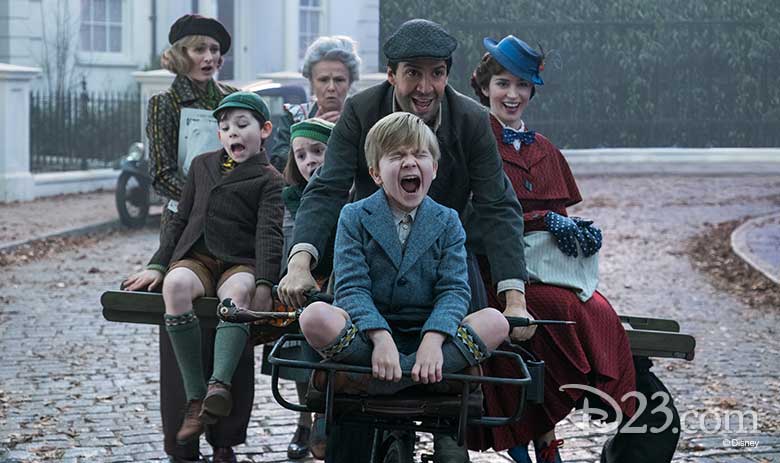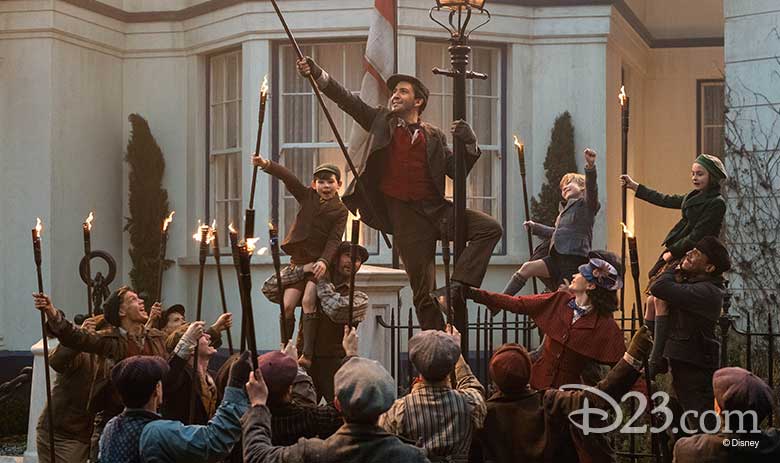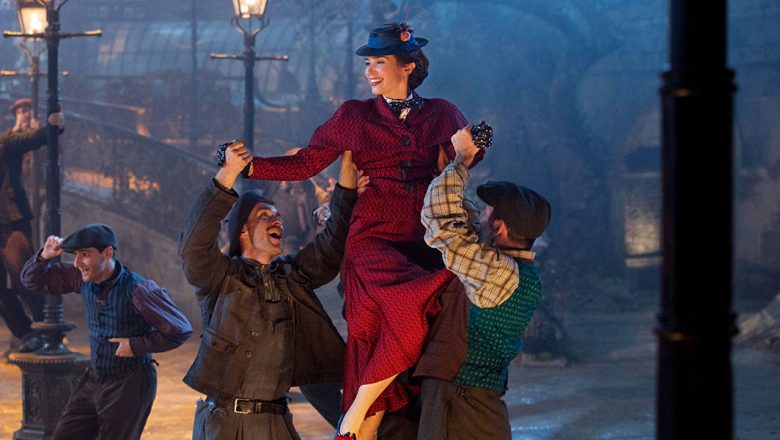By Bruce C. Steele
Visiting the set of Mary Poppins Returns at Shepperton Studios in London reminds you of one of the many reasons the world’s favorite nanny is unique among enchanted movie characters.
As the film’s director, Rob Marshall, puts it, after every spectacular fantasy she conjures, Mary simply “denies any magic that’s ever happened.”
The sound stages at Shepperton do the same: In the middle of the filming, much of the movie magic has already dissolved from reality into memory, captured by cameras but denied by the physical evidence.
Cherry Tree Lane, the London street made famous in the first Mary Poppins? It’s been here and gone, nothing left but the empty shell of one remaining house, shoved into a corner of a sound stage. It sits abandoned in the shadow of a full-size replica of the pinnacle of the London clock tower known as Big Ben, now being built where the lane once stood.

The familiar upstairs nursery in the Banks’ house on that vanished lane? It’s still standing in another part of the studio, but without a ceiling, its contents scattered and sharing the space with random pieces of film equipment.
Sure, step around the movie lights on black metal poles and you’ll find plenty of evidence of the Poppins tale that’s still being spun here: stuffed animals abandoned in a toy box, a child’s hand-crafted dollhouse, and—in Mary Poppins’ own room—green hairbrushes sitting on a dresser next to a handheld mirror, slightly dusty, that you know once shimmered with the nanny’s radiant face.
It’s all the same but different, as the movie takes us to the London of the 1930s, 25 years after the original film, when Jane and Michael Banks are adults and Michael is a father with three children of his own, nearly incapacitated by grief over the loss of his wife. The family is in desperate need of Mary Poppins.
But what’s that sound? It’s the ebullient melody of one of the movie’s many original new songs by Marc Shaiman and Scott Wittman. A jaunty male chorus intoning “Trip a Little Light Fantastic” is playing over loudspeakers, pouring joy and foot-tapping energy into the air.
If you follow the music, walking past a workshop where a half-dozen mechanics are busy working on some 1930s-style bicycles, you’ll find where the Poppins magic has now taken hold.
Inside another sound stage, a small army of London lamplighters — “leeries,” as they’re called — are performing a complicated dance number on a vast, elaborate set in the guise of a London park, an eight-minute extravaganza that will come complete with stunts on all those bikes being assembled next door. The dancers are watched by dozens of crew members — not just by camera operators and lighting technicians, but by costume and hair-and-makeup assistants and set decorators, all ready to make any flaw disappear in an instant.
In the context of the movie, however, the leeries’ audience is much smaller: just Michael Banks’ three children and Mary herself, her practically perfect persona brought back to luminous life by Emily Blunt, who Marshall says “was born to play the role.”
Before the cameras roll again, the lean and limber leeries stand at attention — all dressed in variations on tan pants, black jackets and newsboy caps — getting direction from Marshall, his voice godlike as it fills the studio: “No one can be where Grant is right now,” he says, as third assistant director Grant Butler marks out a forbidden spot on the set.
In a break before the next take, one leerie does chin-ups on the lamppost to which he’s been assigned, bathed like every pole on the set in an otherworldly pool of light. “OK,” says Marshall’s disembodied voice. “Let’s go back to Lin’s section.”

The cameras then focus on Jack, the chief leerie, played by Lin-Manuel Miranda, the actor-singer-songwriter-etc. who created the Broadway phenomenon Hamilton. His Jack — a protege of the now-departed Bert from the 1964 film — is Mary’s ally throughout the many adventures of Mary Poppins Returns.
And what a lot of adventures there will be, drawn from the original stories by British author P.L. Travers, who wrote eight Mary Poppins books from 1934 to 1988. The tales are timeless, and whatever the era — Edwardian England, the Great Depression or the present day — “what you realize,” producer Marc Platt says, “is that the magic, the hope, the optimism, the connectivity that Mary Poppins brings as a character to the family and the world around her is really what people are yearning for.”
The filming at Shepperton is continuing as Platt speaks, but he’s removed from the action, introducing visitors to the wonders of the studio’s circus-tent-like Orangery. The vast space is overflowing with costumes, props, concept art, set models, and more items used so far in the making of the film.
There’s an antique wheelchair fitted with a scabbard and sword — the mobile throne of David Warner’s Admiral Boom, the Banks’ Cherry Tree Lane neighbor. There’s a miniature version of the “Royal Doulton Music Hall” set, a theater made of giant books that will be entirely hand-drawn in the movie’s animation-with-live-action fantasy sequence. And there are several iterations of Mary’s signature dark blue coat, this time with cream-colored polka dots hidden in the lining.
Not among the dozens of collected props in the Orangery is one of Marshall’s favorite items: a recreation of the snow globe featured in the “Feed the Birds” number in the previous film, which the children in Mary Poppins Returns find in the attic on Cherry Tree Lane.
Years from now, you can imagine another attic revealing one of the many treasures here displayed — perhaps the belt buckle with an upside down clock face that was worn by Meryl Streep in her role as Mary’s cousin Topsy. Maybe the gold pirate coins and red beach bucket used in a nautically themed song titled “Imagine That,” which Mary sings during bath time early in the movie. Or perchance a rack of children’s whistles and colorful tops that belongs to a vendor in the movie’s finale, a tune titled “Nowhere to Go But Up.”
Because any of these many marvelous objects could spark new flights of imagination in the minds of future believers.
Mary Poppins is, of course, all about imagination, both the kind that a nanny uses to bring joy to a floundering family and the kind Marshall and his Disney-powered team use to bring this story to life in Mary Poppins Returns. Because without imagination, even a giant clock tower inside a sound stage is just a fancy pile of two-by-fours and nails and paint.





